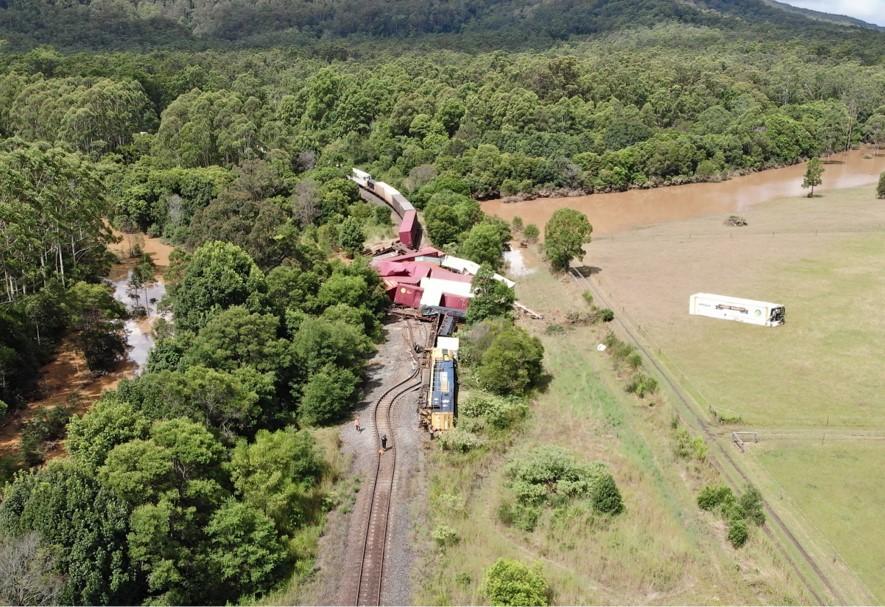
|
Key points
|
A systemic transport safety investigation has highlighted a range of issues related to risk management, and the identification and response to extreme weather by the operators involved in a significant freight train derailment on the New South Wales north coast.
In the early hours of 25 February 2021, a southbound Pacific National freight train derailed near Nana Glen, where floodwaters had built up and overtopped the track, washing away ballast.
Rolling stock, freight and a large section of railway were significantly damaged, one of the two crew on board the train sustained minor injuries, and the line was closed for nine days.
An investigation into the accident was conducted by the Office of the Transport Safety Investigations (OTSI), which undertakes rail investigations in NSW on behalf of the Australian Transport Safety Bureau.
It found that the track manager ARTC had not adequately identified or addressed the risk of flooding along the rail corridor or the culvert near the accident site, as well as numerous others along the Mid North Coast.
“ARTC could not reliably determine the risk of flooding along the section of rail corridor where the accident occurred, and it had not undertaken formal assessments to determine the need for, or the locations of, remote weather monitoring stations to detect extreme weather events,” OTSI Chief Investigator Dr Natalie Pelham said.
“Extreme weather events pose a significant risk to the rail network and are likely to increase in frequency and intensity in the future.
“These events can affect the integrity and exceed the design of rail infrastructure so infrastructure managers must ensure they have effective systems in place to identify, assess and manage the risks so that trains are prevented from entering sections where the design of the infrastructure will be exceeded.”
The investigation found network users were not aware of the extent of the severe weather event and had not been advised of an ‘amber alert’ issued prior to the derailment.
“Although ARTC had procedures in place to monitor and respond to extreme weather events, the process had significant limitations,” Dr Pelham said.
“The mechanism for alerting operational personnel, which was an email, did not ensure that alerts were always identified, or actioned, in a timely manner. Additionally, the actions specified were insufficient to respond to escalating rainfall and flooding events, both forecast and actual.”
The investigation also found that the weather alerts issued by the weather service provider did not reliably reflect the data and frequency of ARTC’s extreme weather monitoring procedure or the service agreement.
Separately, the report notes that two trains which had earlier passed through the derailment site – including an XPT passenger service which passed through 27 minutes before the derailment – had not reported a condition affecting the network. These drivers had not been provided with guidance for operating through severe weather conditions and floodwater. And, although visibility was severely affected, the drivers did not slow down.
“This reduced their opportunity to sight signals and potential obstructions, and to safely traverse level crossings,” Dr Pelham noted.
Since the accident, ARTC has taken several safety actions, including installing 20 more remote weather stations along the Telarah to Acacia Ridge corridor, developing and implementing a work instruction for the management of flooding and special locations, and issuing a safety bulletin increasing rainfall and flooding alerts by one category.
“We welcome these and other actions undertaken by the network operator, however our report also makes two recommendations for further safety action to be undertaken by both ARTC and Pacific National,” Dr Pelham said.
The recommendations stem from the same finding – that neither ARTC nor Pacific National provided guidance for train crew to respond to extreme wet weather events or floodwater in the rail corridor.
“There was no guidance for when trains should stop or report if there was water on the track formation, covering the ballast, sleepers or the rail,” Dr Pelham explained.
“Both rail infrastructure managers and rolling stock operators must ensure they provide guidance and operational procedures to enable consistent responses to conditions that may adversely affect the integrity of rail infrastructure and operational safety.”
Read the report: Derailment of freight train 4BM4, Nana Glen, New South Wales, on 25 February 2021


